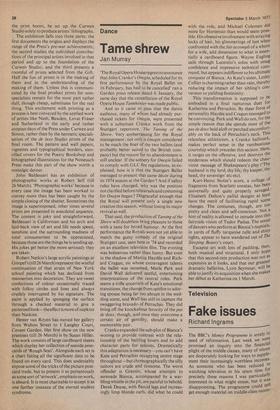Art
Pioneer press
John McEwen
Artists at Curwen (Tate till 3 April) was put together at two months' notice to fill a gap. In the circumstances, its organiser, Pat Gilmour, the first curator of the Gallery's recently formed Print Collection, has done a remarkable job. But despite her excellent catalogue—no less than a small book in length—and the clarity of her presentation, there is no disguising that this is a sideshow padded out to fill the space of a major exhibition.
The twentieth-century Print Collection at the Tate was formed as a result of a massive gift from the Institute of Contemporary Prints in 1975. Seven hundred and fifty of these prints were donated to the Institute by the Curwen Studio, an offshoot of the Curwen Press, which was founded in 1959 as the first lithographic atelier of its kind in England. The point of the exhibition is to display a selection of these prints, but to place them in context and make it more of a show. Pat Gilmour has gathered together works and documentation which chronicle the whole Curwen enterprise from the end of the First World War.
Harold Curwen's innovation at the Press in the 'twenties was to involve the new generation of artists in commercial printing. The fashion among small presses at the time was for etching and de luxe editions all done by hand. Harold Curwen saw no reason why machine printing should not go hand in hand with craft skill, nor did he see any reason for art to be precious. In a William Morris way he wanted good taste to permeate every quarter of design. His nonconformist perfectionism and spirit of cooperative endeavour were matched by the even more zealous puritanism of his partner and successor, the typographer Oliver Simon. Timothy Simon, Oliver's son, completed the third stage of the Press's involvement with artists when in the much changed atmosphere of the late 'fifties, just prior to
the print boom, he set up the Curwen Studio solely to produce artists' lithographs.
The exhibition falls into three parts: the first documents the origins and displays the range of the Press's pre-war achievements; the second studies the individual contributions of the principal artists involved in that period and up to the foundation of the Curwen Studio; and the third presents a roomful of prints selected from the Gift. Half the fun of prints is in the making of them and in the understanding of the making of them. Unless this is communicated by the final product prints for nonspecialists remain for the most part rather dull, though cheap, substitutes for the real thing. This excitement with printing as a process is best conveyed by the applied work of artists like Nash, Bawden, Lovat Fraser and Sutherland in the early and rather utopian days of the Press under Curwen and Simon, rather than by the hermetic specialisation of the de luxe Studio prints of the final room. The pattern and wall papers, vignettes and typographical borders, stencilled covers for the Poetry Bookshop and lithographed illustrations for the Nonesuch Press make this part of the show worth a nostalgic detour.
John Baldessari has an exhibition of photographic works at Robert Self (till 26 March). 'Photographic works' because in every case the image has been worked to convey more than has been caught by the simple closing of the shutter. Sometimes the image is superimposed, other times several prints are presented in anecdotal sequence. The content is joky and straightforward. Baldessari is Californian and his arch and laid-back view of art and life needs speed, sunshine and the surrounding madness of total consumerism to be appreciated, because those are the things he is sending up. His jokes get better the more seriously they are taken.
Robert Natkin's large acrylic paintings at G impel's (till 26 March) represent the wistful continuation of that strain of New York school painting which has declined from mannerism into decoration. They are sweet confections of colour occasionally traced with folksy circles and lines and always crudely interrupted by his signature. The paint is applied by sponging the surface through a checked material to give a patterned look—the effect is more of napkins than Natkins.
Hester van Royen has moved her gallery from Walton Street to I Langley Court, Covent Garden. Her first show on the new premises (till 26 March) is by Susan Hiller. The work consists of large cardboard sheets which display her collection of seaside postcards of 'Rough Seas'. Alongside each set is a Chart listing all the significant data to be found on every card. This does undeniably expose some of the tricks of the picture postcard trade, but to present it so portentously as some sort of 'artwork', emphasis on work, is absurd. It is most charitable to accept it as one further instance of the eternal student syndrome.



































 Previous page
Previous page